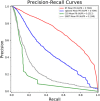Geometric complement heterogeneous information and random forest for predicting lncRNA-disease associations
- PMID: 36092871
- PMCID: PMC9448985
- DOI: 10.3389/fgene.2022.995532
Geometric complement heterogeneous information and random forest for predicting lncRNA-disease associations
Abstract
More and more evidences have showed that the unnatural expression of long non-coding RNA (lncRNA) is relevant to varieties of human diseases. Therefore, accurate identification of disease-related lncRNAs can help to understand lncRNA expression at the molecular level and to explore more effective treatments for diseases. Plenty of lncRNA-disease association prediction models have been raised but it is still a challenge to recognize unknown lncRNA-disease associations. In this work, we have proposed a computational model for predicting lncRNA-disease associations based on geometric complement heterogeneous information and random forest. Firstly, geometric complement heterogeneous information was used to integrate lncRNA-miRNA interactions and miRNA-disease associations verified by experiments. Secondly, lncRNA and disease features consisted of their respective similarity coefficients were fused into input feature space. Thirdly, an autoencoder was adopted to project raw high-dimensional features into low-dimension space to learn representation for lncRNAs and diseases. Finally, the low-dimensional lncRNA and disease features were fused into input feature space to train a random forest classifier for lncRNA-disease association prediction. Under five-fold cross-validation, the AUC (area under the receiver operating characteristic curve) is 0.9897 and the AUPR (area under the precision-recall curve) is 0.7040, indicating that the performance of our model is better than several state-of-the-art lncRNA-disease association prediction models. In addition, case studies on colon and stomach cancer indicate that our model has a good ability to predict disease-related lncRNAs.
Keywords: autoencoder; geometric complement heterogeneous information; lncRNA-disease association prediction; machine learning; random forest.
Copyright © 2022 Yao, Zhang, Zhan, Zhang, Zhan and Zhang.
Conflict of interest statement
The authors declare that the research was conducted in the absence of any commercial or financial relationships that could be construed as a potential conflict of interest.
Figures
Similar articles
-
A random forest based computational model for predicting novel lncRNA-disease associations.BMC Bioinformatics. 2020 Mar 27;21(1):126. doi: 10.1186/s12859-020-3458-1. BMC Bioinformatics. 2020. PMID: 32216744 Free PMC article.
-
CNNDLP: A Method Based on Convolutional Autoencoder and Convolutional Neural Network with Adjacent Edge Attention for Predicting lncRNA-Disease Associations.Int J Mol Sci. 2019 Aug 30;20(17):4260. doi: 10.3390/ijms20174260. Int J Mol Sci. 2019. PMID: 31480319 Free PMC article.
-
LDAEXC: LncRNA-Disease Associations Prediction with Deep Autoencoder and XGBoost Classifier.Interdiscip Sci. 2023 Sep;15(3):439-451. doi: 10.1007/s12539-023-00573-z. Epub 2023 Jun 12. Interdiscip Sci. 2023. PMID: 37308797
-
DeepWalk based method to predict lncRNA-miRNA associations via lncRNA-miRNA-disease-protein-drug graph.BMC Bioinformatics. 2022 Feb 25;22(Suppl 12):621. doi: 10.1186/s12859-022-04579-0. BMC Bioinformatics. 2022. PMID: 35216549 Free PMC article. Review.
-
LMI-DForest: A deep forest model towards the prediction of lncRNA-miRNA interactions.Comput Biol Chem. 2020 Dec;89:107406. doi: 10.1016/j.compbiolchem.2020.107406. Epub 2020 Oct 20. Comput Biol Chem. 2020. PMID: 33120126 Review.
Cited by
-
Predicting lncRNA-Disease Associations Based on a Dual-Path Feature Extraction Network with Multiple Sources of Information Integration.ACS Omega. 2024 Jul 30;9(32):35100-35112. doi: 10.1021/acsomega.4c05365. eCollection 2024 Aug 13. ACS Omega. 2024. PMID: 39157140 Free PMC article.
-
The application of random forest-based models in prognostication of gastrointestinal tract malignancies: a systematic review.Front Artif Intell. 2025 Jul 18;8:1517670. doi: 10.3389/frai.2025.1517670. eCollection 2025. Front Artif Intell. 2025. PMID: 40756817 Free PMC article.
References
-
- Breiman L. (2001). Random forests. Mach. Learn. 45, 5–32. 10.1023/a:1010933404324 - DOI
LinkOut - more resources
Full Text Sources





